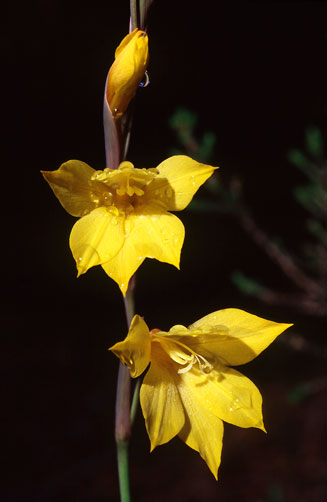|
Gladiolus aureus Life
> eukaryotes >
Archaeoplastida >
Chloroplastida
>
Charophyta > Streptophytina > Plantae (land plants)
> Tracheophyta (vascular plants) > Euphyllophyta > Lignophyta (woody plants)
> Spermatophyta (seed plants) > Angiospermae (flowering
plants) > Monocotyledons > Order: Asparagales
> Family: Iridaceae > Genus:
Gladiolus
 |
|
|
Gladiolus aureus flowering in spring. South
Africa. [photo
Colin Paterson-Jones ©] |
|
Information is from Goldblatt and Manning (1998 pp.
170-171).
Identification
Can be identified on the basis of the following combination
of characters:
- the yellow flowers with tepals of similar size.
- the perianth tube, which is narrow basally and then expands abruptly
10-15 mm from the base.
Distribution and habitat
Endemic to the Cape Peninsula, Western Cape, South Africa
where it is restricted to mountain slopes near Kommetjie and Simonstown. Plants
grow in seeps, where the peaty sand remains wet well into Spring.
Life cycle
- A geophyte with a corm measuring 12-18 mm in diameter.
- Flowers from late August to September.
- The oval seeds are about 9 mm long by 7 mm wide and have broad, evenly
developed wings.
Ecological relationships
Pollinator
- Bees > Apidae > Apis mellifera (Honeybee). The flower does not
have nectar and so the bees are visiting it for pollen.
Publications
- Goldblatt P. and Manning J. 1998. Gladiolus in Southern Africa.
Fernwood Press, Vlaeberg, Cape Town.
Text by Hamish Robertson |
